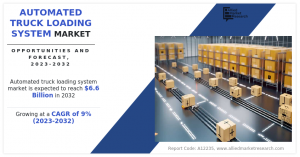Rising Automation Trend Drives Automated Truck Loading System Market to $6.6 Billion by 2032, at 9.0% CAGR Globally
The global ATLS market growth is attributed to various factors, including the rise in rapid industrialization, and an increased safety of the work environment.
WILMINGTON, NEW CASTLE, DE, UNITED STATES, June 27, 2025 /EINPresswire.com/ -- Allied Market Research published a report, titled, "Automated Truck Loading System Market by Loading Dock Type (Flush Dock, Enclosed Dock, Sawtooth Dock, Climate Controlled Dock, Others), by Truck Type (Non-Modified Truck, Modified Truck), by System Type (Chain Conveyer System, Slat Conveyer System, Belt Conveyer System, Skate Conveyer System, Roller Track System, Automated Guided Vehicle, Loading Plate System), by Industry (Automotive and Transportation, Aviation, Construction and Manufacturing, FMCG, Healthcare, Others): Global Opportunity Analysis and Industry Forecast, 2023-2032".According to the report, the global automated truck loading system market size was valued at $2.8 billion in 2022, and is projected to reach $6.6 billion by 2032, registering a CAGR of 9.0% from 2023 to 2032.
An automated truck loading system (ATLS) is a mechanized solution designed to automate the process of loading and discharging goods onto trailers or trucks. It utilizes various technologies, such as robotics, conveyors, and sensors, to efficiently and safely handle the loading and unloading tasks. ATLS typically consists of a combination of robotic arms, conveyors, or other automated equipment that can load and unload pallets or containers, as well as individual items. Systems are programmed to precisely place and secure the load onto the truck. This optimizes space usage and reduces the risk of transport damage.
Download Sample Pages - https://www.alliedmarketresearch.com/request-sample/12600
The automated truck loading system with its potential has helped industries by enhancing safety and reducing accidents in the warehouse. The system has potential to do more, as it can be integrated with various other technologies. For instance, it can be integrated with the warehouse management system which is expected to facilitate load planning, inventory management, and efficient fulfilment of the order. Similarly, Internet of things (IoT) can be integrated with the automated loading system which helps it to communicate with internal components as well as external components of the surrounding in the warehouse or a store unit. Connectivity with different systems is anticipated to help in the predictive maintenance, data sharing, and remote monitoring of the system.
Rise in rapid industrialization, and increased safety of the work environment supplement the growth of the automated truck loading system market. However, high installation charges and availability of inexpensive labors are expected to hamper the growth of the market. In addition, integration of automated truck loading system with other systems and use of advanced robotics are expected to create ample opportunities for the key players operating in the market.
Leading Market Players in Automated Truck Loading System Industry: -
Cargo Floor B.V.
ACTIW LTD.
Euroimpianti S.p.A
HAVER And BOECKER OHG
Secon Components S.L.
Asbreuk Service B.V.
Ancra Systems B.V.
BEUMER Group
Joloda Hydraroll Limited
GEBHARDT Fordertechnik GmbH.
In addition, the automated truck loading market has witnessed significant growth in recent years, owing to rise in the rapid industrialization. Governments across the globe are investing in the industrial sectors to boost the sectors such as manufacturing, agriculture and logistics. Furthermore, companies operating in the market have adopted partnerships, and acquisition to increase their market share and expand their geographical presence. For instance, in June 2022, The FAM Group, a supplier of conveyor systems and loading technologies, was bought by the BEUMER Group. The acquisition is anticipated to help the company improve its offering by using FAM Group technologies.
Interested to Procure the Research Report? Inquire Before Buying - https://www.alliedmarketresearch.com/purchase-enquiry/12600
The flush dock segment to maintain its leadership status throughout the forecast period-
Based on loading dock type, the flush dock segment held the highest market share in 2022, accounting for nearly one-third of the global automated truck loading system market revenue, and is estimated to maintain its leadership status throughout the forecast period. The sawtooth dock plays a vital role due to its angle parking formation, it provides increase docking capability, and space optimization to cater the fleet of trucks to load and unload. The easy process of loading and unloading in the docks can be enhanced with the implementation of the automated loading systems. On the other hand, the others segment would showcase the fastest CAGR of 15.2% from 2023 to 2032.
The non-modified truck segment to maintain its leadership status throughout the forecast period-
Based on truck type, the non-modified truck segment held the highest market share in 2022, accounting for more than three-fourths of the global automated truck loading system market revenue, and is estimated to maintain its leadership status throughout the forecast period. However, the modified trucks would display the fastest CAGR of 11.2% during the forecast period. Modified trucks play a vital role because these trucks can reduce downtime, improve overall operating throughput, and improve the transportation of specific types of cargo, such as metal, wood, or complex items, by adopting these improvements. Logistics firms can cut labor costs and enhance operational efficiency by automating the loading and unloading procedures, thereby saving money in the long term. The operational efficiency and the enhancement in the loading and unloading process achieved with the modified trucks is expected to create market growth during the forecast period.
The belt conveyer system segment to maintain its leadership status throughout the forecast period-
Based on system type, the belt conveyer system segment held the highest market share in 2022, accounting for more than one-fifth of the global automated truck loading system market revenue and is estimated to maintain its leadership status throughout the forecast period. The same segment would also portray the fastest CAGR of 10.9% during the forecast period. This is because a belt conveyor automated loading system typically consists of a belt conveyor, sensors, and control systems. A belt conveyor carries a parcel or package in a continuous loop, which means that the parcel or the package travels along a system of rollers or pulleys. The goods that need to be loaded are placed on the belt conveyor, which transfers them to the required destination, such as a truck bed or a storage space. Sensors are strategically placed along the conveyor to detect the presence of commodities and control the loading process. The sensors and systems include radio frequency identification (RFID), weight sensor, and camera systems. These sensors and systems detect the position, weight, and other properties of the materials, allowing the system to alter the loading procedure as needed. The use of technology with various sensors makes it accurate and safe to work in the warehouses, thus increasing its demand in the automated truck loading system market.
Procure Complete Research Report (PDF with Qualitative and Quotative Data, Insights, Statistics, Tables, Charts, Figures) - https://www.alliedmarketresearch.com/automated-truck-loading-system-market/purchase-options
North America to maintain its dominance by 2032-
Based on region, North America held the highest market share in terms of revenue in 2022, accounting for more than one-third of the global automated truck loading system market revenue and is projected to maintain its dominance throughout the forecast period. On the other hand, the Asia-Pacific region is expected to witness the fastest CAGR of 10.5% during the forecast period. Asia-Pacific is known to be the home of industrial development due to which the market is expected to grow at a suitable growth rate during the forecast period.
David Correa
Allied Market Research
+ 1800-792-5285
email us here
Visit us on social media:
LinkedIn
Facebook
YouTube
X
Legal Disclaimer:
EIN Presswire provides this news content "as is" without warranty of any kind. We do not accept any responsibility or liability for the accuracy, content, images, videos, licenses, completeness, legality, or reliability of the information contained in this article. If you have any complaints or copyright issues related to this article, kindly contact the author above.
The Aku Venue Event Center, LLC Earns 2025 Best of South Carolina Award for Excellence in Event Hosting and Planning
Pre-Orders Opened on July 18 for 'Guts Berserker Armor ‘Rage’' Plastic Model Kit
A Voice of Light: Viviana Puello’s Journey Through Music, Film, and Soul
Kalendarium
Więcej ważnych informacji
 Jedynka Newserii
Jedynka Newserii

 Jedynka Newserii
Jedynka Newserii

Prawo

KE proponuje nowy Fundusz Konkurencyjności. Ma pobudzić inwestycje w strategiczne dla Europy technologie
W środę 16 lipca Komisja Europejska przedstawiła projekt budżetu na lata 2028–2034. Jedna z propozycji zakłada utworzenie Europejskiego Funduszu Konkurencyjności o wartości ponad 400 mld euro, który ma pobudzić inwestycje w technologie strategiczne dla jednolitego rynku. Wśród wspieranych obszarów znalazła się obronność i przestrzeń kosmiczna. Na ten cel ma trafić ponad 130 mld euro, pięciokrotnie więcej niż do tej pory.
Firma
Były prezes PGE: OZE potrzebuje wsparcia magazynów energii. To temat traktowany po macoszemu

Choć udział odnawialnych źródeł energii w miksie energetycznym Polski jest stosunkowo wysoki i rośnie, to ten przyrost jest chaotyczny i nierównomiernie rozłożony miedzy technologiami – wskazuje Forum Energii. Dodatkowo OZE potrzebują wsparcia magazynów energii, a zdaniem Wojciecha Dąbrowskiego, prezesa Fundacji SET, ten temat jest traktowany po macoszemu. Brak magazynów powoduje, że produkcja energii z OZE jest tymczasowo wyłączana, co oznacza marnowanie potencjału tych źródeł.
Infrastruktura
Wzrost wynagrodzeń ekip budowlanych najmocniej wpływa na koszty budowy domu. Zainteresowanie inwestorów mimo to nieznacznie wzrasta

Budowa metra kwadratowego domu w Polsce kosztuje od 5,55 do 6 tys. zł w zależności od województwa – wynika z najnowszych analiz firmy Sekocenbud. Najdrożej jest w Warszawie, gdzie cena za metr kwadratowy domu przekroczyła już 6,2 tys. zł. Na przyrosty kosztów budowy domu wpływają zarówno drożejące materiały budowlane, jak i wyższe wynagrodzenia pracowników. Inwestorzy nie rezygnują jednak z budowy domów jednorodzinnych, co ma związek m.in. z wciąż wysokimi cenami mieszkań czy też obniżką stóp procentowych.
Partner serwisu
Szkolenia

Akademia Newserii
Akademia Newserii to projekt, w ramach którego najlepsi polscy dziennikarze biznesowi, giełdowi oraz lifestylowi, a także szkoleniowcy z wieloletnim doświadczeniem dzielą się swoją wiedzą nt. pracy z mediami.









.gif)

 |
| |
| |
|